A modern person always needs to look good. After all, today part of the saying “You meet someone by their clothes...” is so relevant. To be more precise, by the general appearance of a person. So, this is why the skin must be in perfect condition. What is the cause of internal acne on the face, and what ways can you cope with the problem? This will be discussed further.
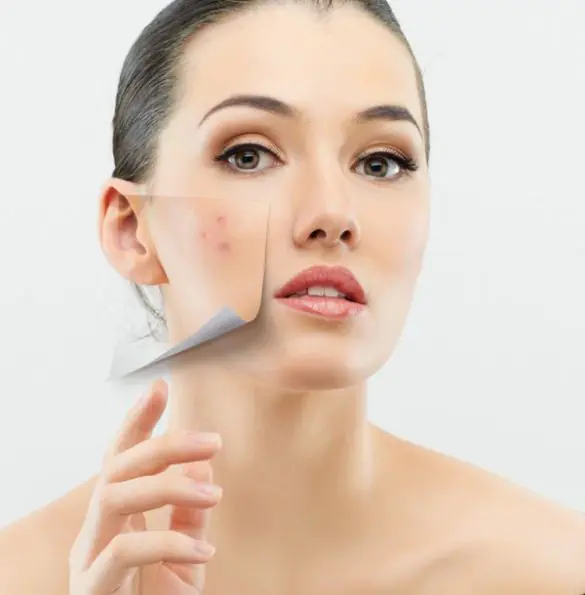
Basic information about acne
Initially, I would like to note that this problem - acne - is typical not only for adolescents during hormonal changes (which, however, is most often observed), but also for adults. Essentially, this is an inflammatory process affecting the ducts of the sebaceous glands. A large amount of pus accumulates in the subcutaneous layer, which causes the formation of tubercles in various areas of the facial skin. It is noteworthy that these formations can be localized in any part of the body. The most favorite places for such pimples are the neck, cheekbones, chin, as well as the arms and back.
About the types of subcutaneous acne
It is also worth noting that subcutaneous pimples can be of two main types:
- White pimple. This is a pustule filled with pus, located under the skin.
- Red pimple. This is tissue inflammation. Due to edema, it often increases in size, after which it may disappear completely without outside intervention.
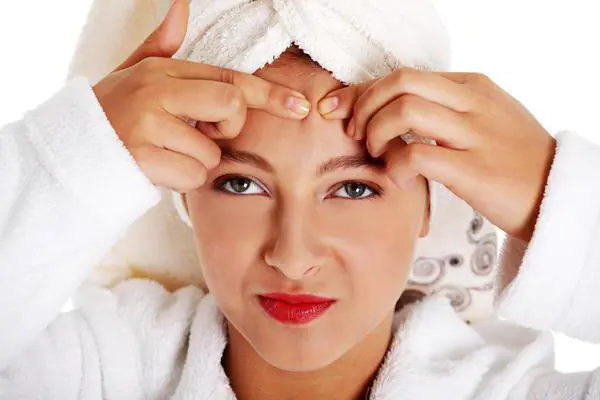
About the causes of such acne
It is imperative to consider the causes of internal acne on the face. After all, knowing why they arise, you can try to protect yourself from this scourge.
- The first and main reason is the improper functioning of the hormonal system, its failure, disruption. It most often occurs in three main cases: during teenage changes, pregnancy, and also during menopause.
- The next important and common cause of internal acne on the face is various skin diseases, as a result of which the production of subcutaneous sebum is disrupted. An example would be a disease such as seborrhea.
- Failure in the functioning of immune cells, as a result of which pathogenic microflora actively multiplies on the skin of various parts of the face.
- A very common cause of internal acne on the face is poor hygiene of the face and entire body, incorrect selection of cosmetics, and increased sweating.
- Very often the cause is a violation of the integrity of the sebaceous gland due to mechanical reasons, for example, squeezing out pimples.
- A similar unpleasant phenomenon can also be caused by a subcutaneous mite called demodex. It is capable of parasitizing in the follicles of not only body hair, but also facial hair.
- And the last very common cause of internal acne on the face is poor diet. So, a similar phenomenon can be caused by fatty, salty or sweet foods if they enter the body in excess.
It should be noted that these are the most common and common causes. However, some individual cases may not fall under this classification.

Localization of acne and main problems
Having understood why internal pimples can form on the face (the reasons were discussed above), I would also like to say that their localization can be directly related to problems of internal organs.
- Forehead area. In this case, doctors say that you need to make sure that everything is in order with the intestines. The cause may be problems such as colitis or dysbiosis.
- We further study the occurrence of such a problem as internal acne on the face and its causes. They can appear on the chin if there are disturbances in the functioning of the pelvic organs or reproductive system. The thing is that the hair follicles located on the chin respond well to changes in the level of one or another hormone.
- An internal pimple in the area between the lips and nose may indicate a malfunction of the cardiovascular system.
- What other reasons are there that contribute to the appearance of internal acne on the face? They form on the cheekbones and cheeks if there are malfunctions in the stomach and liver. In this case, it is also good to further examine the intestines.
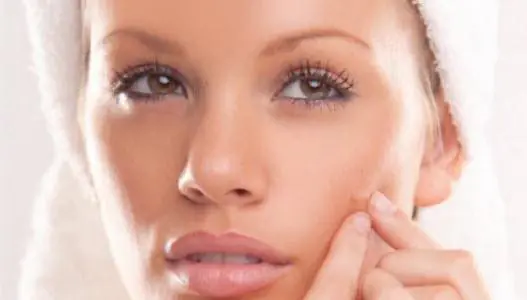
The main thing to remember!
When figuring out how to remove an internal pimple on the face, you need to remember the main rule: never, under any circumstances, squeeze out such pimples. It is strictly forbidden to do this with unwashed hands or on uncleaned skin. This can lead to the growth of the inflammatory process area, and in some cases even to blood poisoning. Improper handling of such formations can lead to the formation of scars on the skin, which is almost impossible to correct in the future. Scars remain for life, spoiling a person’s appearance.
Visit to the doctor
If a person is interested in how to remove an internal pimple on the face, you need to seek help from a doctor. Initially, you need to go to an appointment with a dermatologist. He will assess the condition of the skin, its damage, and possible problems. Most often, in this case, the doctor will refer you for tests to examine the functioning of the gastrointestinal tract. If everything is in order with the tests, the dermatologist delegates his powers to the cosmetologist.
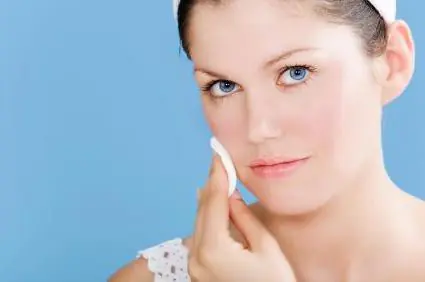
Face cleaning
If an internal pimple appears on the face, a cosmetologist will tell you how to get rid of it. So, first of all, most likely, he will recommend cleaning the skin. It can be of several types:
- Mechanical, when cleansing of pimples is done by the hands of a cosmetologist.
- Chemical, when skin cleansing occurs with the help of specially selected masks.
- Vacuum, which is carried out not by the hands of a doctor, but by a special apparatus. In this case, the pain is practically zero, and the person is not tormented by unpleasant sensations.
- Galvanization procedure. In this case, the human skin is exposed to a low-intensity current. This is necessary in order to enhance the effect of medications and masks previously applied to the patient’s face.
Peeling
To cope with such problems, you can use a peeling procedure. However, conventional drugs are unlikely to help in this case. It is best to contact a cosmetologist for help. In this case, a specialist may recommend a hard peeling procedure called microdermabrasion. In this case, microcrystals are used that deeply cleanse the patient’s facial skin. Doctors also use acid peeling. The essence of this procedure remains the same - cleansing, but in this case the deeper layer of the epidermis is affected.
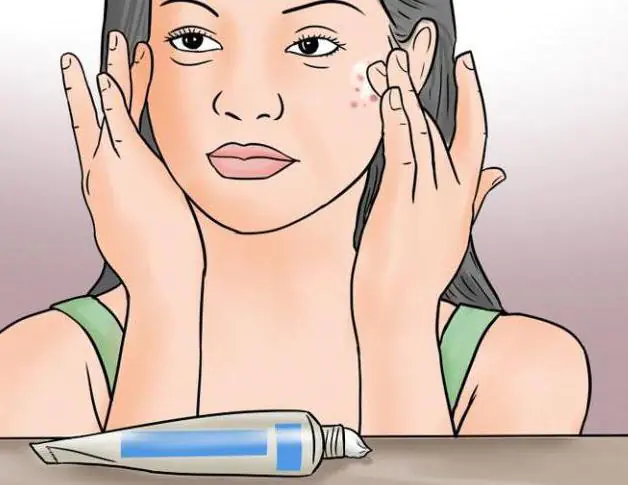
Other cosmetic procedures
Understanding what internal acne on the face is, the causes and treatment of these formations, I would also like to talk about other procedures that can also help cope with the problem.
- Cosmetologists often use laser facial resurfacing, when the top layer of skin cells is removed with special equipment.
- Doctors often also use mesotherapy. This is the introduction of certain medications under the skin of the face using a thin needle.
- To make the pimple ripen faster, doctors also use ozone-oxygen injections.
- The disincrustation procedure involves opening the pimple and thoroughly cleaning the cavity where the pus is located. This should only be done by a highly qualified specialist. Otherwise, you can significantly harm your body, and ugly scars will remain on your face.
- In beauty salons, Elos therapy is also used, when the foci of inflammation are exposed to light.
Severe cases
It often happens that skin lesions can be classified as severe. And the above procedures turn out to be completely ineffective. What to do in this case? The doctor may advise the following:
- Often, specialists prescribe antibacterial drugs. These could be medications such as Tetracycline or Unidox-solutab.
- If we are talking about women, they may have a lack of estrogen in their body. In this case, a specialist may prescribe medications that contain estradiol.
- Zinc preparations work well to combat the problem. These may be products such as Zincteral or Zinc Sulfate.
- Ointments that also contain antibiotics can be used locally. The most commonly prescribed drugs are Triclosan, Levomekol, tetracycline or syntomycin ointment.
- Doctors also attribute vitamins A, C, E and B, omega-3 and omega-6 acids. Brewer's yeast is effective in combating this problem.
- Experts may also prescribe a procedure such as autohemotherapy. In especially severe cases, the patient may be injected intramuscularly with his own venous blood.
Traditional medicine
If an internal pimple appears on the face, how to get rid of such a problem? If this is an isolated phenomenon, you can try turning to traditional medicine. Effective recipes:
- In this case, it is good to wash your face daily with an infusion of calendula flowers or St. John's wort herb. It’s simple to prepare the product: pour one tablespoon of the ingredient of your choice into a partial glass of boiling water.
- Calendula infusion sold at the pharmacy will get rid of subcutaneous acne. They need to wipe the affected areas of the skin every day.
- A lotion made from water and lemon juice, prepared in a 1:1 ratio, is effective. You need to wipe your skin with it twice a day.
- Aloe will also help get rid of subcutaneous acne. Its leaf needs to be cut lengthwise, beaten a little and applied to the affected area for half an hour.
- You can also make a homemade scrub. To do this, take one teaspoon of ground coffee and mix it with 25 ml of tea tree oil. This procedure can be performed no more than twice a week.
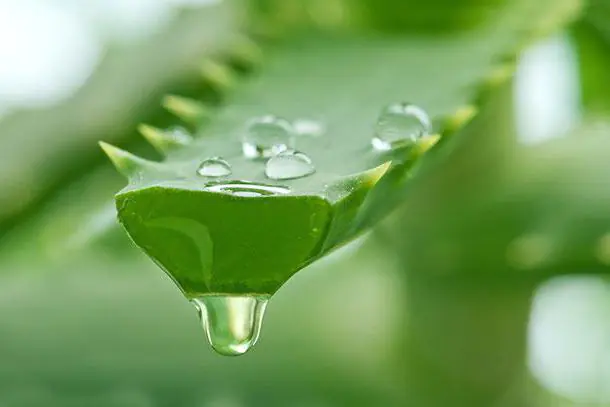
Preventive measures
Having considered such a pathology as internal acne on the face, the causes, photos of this problem, I would also like to finally talk about how you can prevent the occurrence of these unpleasant formations. So, you need to eat right and give up bad habits. It is important to get enough sleep without overloading the body. It is also necessary to promptly treat various diseases, paying attention to chronic ailments. It is strictly forbidden to injure the skin (this is especially easy to do if you squeeze out pimples)! And, of course, you need to regularly treat your facial skin thoroughly with well-chosen cosmetics or infusions for washing, prepared from a collection of herbs.
Acne on the face or various parts of the body is often a consequence of internal disorders that arise due to errors in lifestyle, exposure to adverse factors or developing diseases. One of these problems is subcutaneous formations, which are not just an unpleasant aesthetic defect, but also a possible symptom of pathological processes occurring in the body.
What are subcutaneous acne
The process of formation of subcutaneous skin is directly related to the excessive production of sebum, which accumulates in the sebaceous ducts. It is a breeding ground for bacteria that multiply inside the sebaceous glands and provoke subcutaneous inflammation. As a result of the inflammatory process, a hard ball (bump) appears on the skin, which hurts when pressed and, unlike skin rashes such as pimples or acne, is not squeezed out in the usual way.
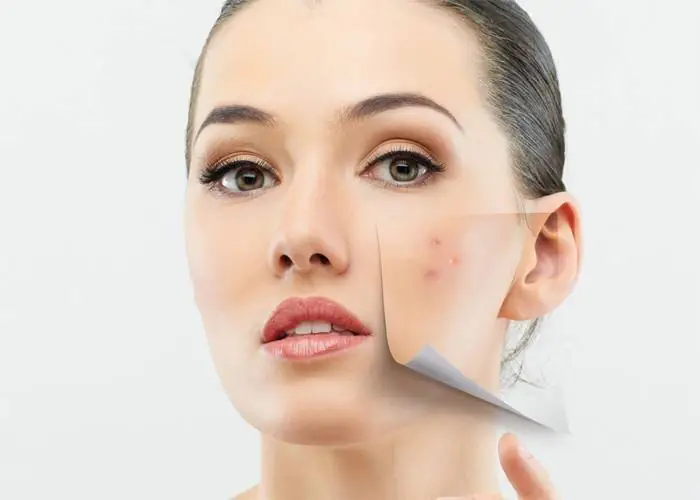
Inflammation affects the inner layers of the skin, and its superficial keratinized layer creates an obstacle to the normal cleaning of the sebaceous ducts. For this reason, it is difficult to get rid of subcutaneous acne, whether it is small white rashes or one large inflamed subcutaneous area. Such formations are located in the deep layers of the skin and “ripe” for a very long time, and therefore it is impossible to remove accumulations of sebum and pus from them using conventional methods.
Reasons for appearance
Having understood what subcutaneous acne is and what is the mechanism of its formation, it is necessary to find out what causes it. The main reason for the appearance of such rashes is a disruption in the process of sebum secretion, and it develops under the influence of a number of internal pathologies or external adverse influences. Why do subcutaneous lesions appear? Experts name the following factors that contribute to or provoke their formation:
- improper or insufficient skin care;
- hormonal imbalance associated with puberty, pregnancy, contraceptives, or endocrine diseases;
- overheating or hypothermia of the body;
- poor nutrition;
- abuse of peeling or tanning;
- disturbances in the gastrointestinal tract;
- reduced immunity;
- metabolic disease;
- hereditary predisposition;
- gynecological diseases;
- subcutaneous mite;
- bad habits (tobacco use, alcohol use).
On the face
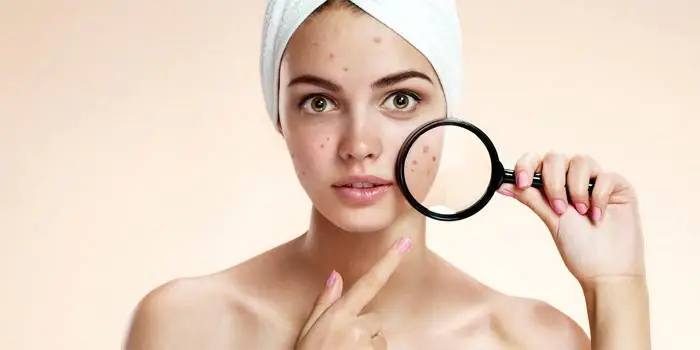
Problems with facial skin, manifested in the form of subcutaneous acne, often indicate hormonal imbalances in the body:
- If small bumps appear on the face that do not go away for a long time, this may be a consequence of developing endocrine pathologies or temporary hormonal imbalance due to natural causes (adolescence, pregnancy).
- In women, white pimples on the face can occur due to ovarian dysfunction caused by polycystic disease. In this case, they are localized on the chin and on the lower cheeks.
- In people with oily or thick skin, internal acne on the face appears due to excessive sebum production and can be located anywhere - on the forehead, nose, cheekbones, chin.
- Painful lumps on the lips that initially look like pimples can be a sign of herpes.
On the back
The appearance of subcutaneous lesions on the back can also be a consequence of sudden hormonal changes, but this phenomenon is often observed in athletes or people leading an active lifestyle. During physical activity, the back constantly sweats, and this contributes to the contamination of the sebaceous ducts and the accumulation of sebum in them, leading to the development of the inflammatory process and the appearance of acne. Find out how to remove acne on a woman's back.
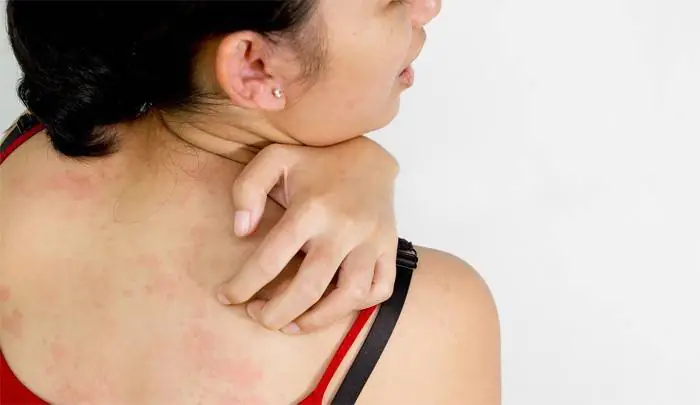
On the neck
Rashes on the neck, located in the deep layers of the epidermis, rarely occur, since the skin in this part of the body is thin. If such pimples appear in this area, it is recommended to undergo a comprehensive medical examination, since they may be associated with diseases of the internal organs or the beginning of the development of pathological processes in the body.
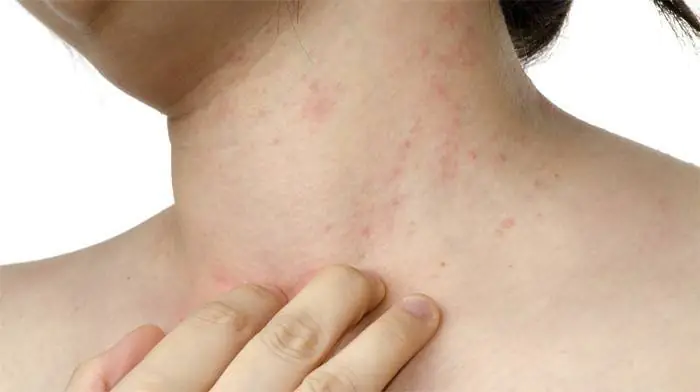
On hands
The appearance of subcutaneous rashes on the hands may indicate endocrine disorders, allergies, and hereditary diseases. If acne appears below the elbow or in the area of the hands, this should be especially alarming, because in these areas there are fewer sebaceous glands and the appearance of skin formations on them can indicate serious pathologies and malfunctions of the body.
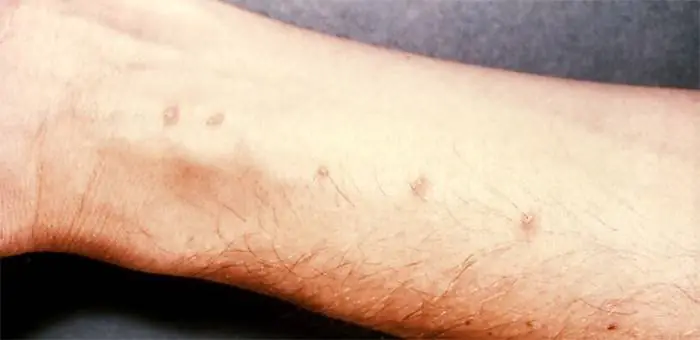
On the labia
Subcutaneous formations in the genital area in many cases occur due to hypothermia of the body. They may appear after a cold, swimming in cold water or improper hardening. Other possible causes are microtraumas that occur during hair removal in the bikini area, as well as wearing synthetic underwear, which irritates the skin and causes it to overheat.
Subcutaneous bumps all over the body
If subcutaneous rashes are located throughout the body, this may be a manifestation of a genetic disease - hereditary lipomatosis. With this disease, bumps can appear on any part of the body - neck, arms, legs, stomach, back. This disorder requires careful examination and long-term complex therapy, and sometimes surgical intervention.
How to get rid of internal pimple
If there are a lot of subcutaneous formations and they do not go away for a long time, it is unlikely that you will be able to get rid of them on your own. In such cases, consultation with a dermatologist and special therapy are necessary. The same applies to such an unpleasant manifestation as acne on the face located deep under the skin, the treatment of which must be carried out under the supervision of a specialist.
However, if the pimple is single and has appeared recently, you can try to remove it without seeking medical help by using available pharmacy and home remedies. How to remove the subcutaneous tissue? Such pimples “mature” for a long time, over several weeks, so attempts to squeeze them out will be unsuccessful. How to treat the skin to speed up this process and prevent complications from developing?
Ointment
An excellent remedy for combating subcutaneous skin are Vishnevsky ointment, Levomekol, and zinc ointment. How to pull out a pimple using these drugs? Ointments should be applied to the affected areas at least 2 times a day. In addition, compresses made from ichthyol ointment have a good effect, drawing the contents of the subcutaneous tissue out. It is recommended to apply them at night.
Cream for subcutaneous acne
When treating subcutaneous rashes, creams with an antibacterial and healing effect are helpful, allowing you to quickly stop the inflammatory process and accelerate tissue regeneration in the affected area. The most effective products in this category, recommended for the fight against subcutaneous skin, are the creams “Baziron”, “Differin”, “Skinoren”, “Klenzit-S”.
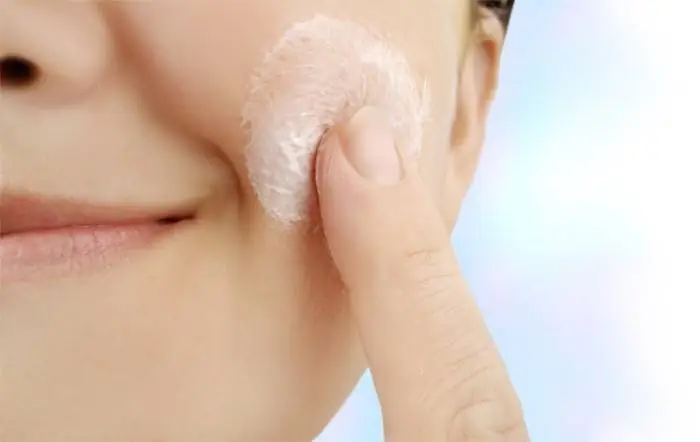
Treatment with folk remedies
Simple folk recipes that are available for use at home will help eliminate subcutaneous formations:
- Aloe compress. It helps well to get rid of such an unpleasant phenomenon as a long-lasting purulent pimple that cannot burst on its own. Cut an aloe leaf, apply it to the site of inflammation and secure with a bandage. It is most convenient to apply the compress at night.
- Tea tree oil. Apply it to your pimples every 3-4 hours for a few days until you notice improvement.
- Mask of oil and garlic. Lubricate the problem area with vegetable oil, and then precisely apply chopped garlic to the area of inflammation and place gauze soaked in hot water over it. Leave on for 20 minutes and rinse off.
How to squeeze a pimple
When deciding to squeeze out a pimple located deep under the skin, it is very important to remember the high risk of infection, even wider spread of rashes or scarring on the skin. A fully mature pimple can be squeezed out after first disinfecting your hands and treating the wound with an antibacterial solution. However, the removal of multiple formations must be entrusted to a dermatologist or cosmetologist.
Video: how to cure an internal pimple
Once and for all, special video materials will help you deal with the problem of subcutaneous rashes, in which this topic is covered in as much detail as possible. Experts talk about the main reasons for the appearance of such formations, provide photos of common types of rashes, explain how to deal with them and how to properly remove a pimple located in the deep layers of the epidermis.
Internal acne on the face is a consequence of the accumulation of excess sebum and particles of dead epidermis in the pores. Clogged pores are an ideal habitat for bacteria, which cause inflammation in both the superficial and deep layers of the epidermis. Internal or subcutaneous pimples are usually characteristic of severe acne.
Acne classification by severity
Depending on the severity of acne, four degrees are distinguished:
In the first degree, acne is mild. Acne and the inflammatory process are usually localized in the superficial layer of the epidermis. They are a few comedones.
The second degree refers to the moderate severity of the dermatological disease. Its difference from the mild form lies in the more extensive damage to the skin of the face, as well as the torso. In addition to comedones, isolated papules and pustules are observed.
In the presence of the third stage, which refers to a severe form of acne, a papulopustular rash is observed affecting the deeper layers of the epidermis. Such internal pimples have characteristic, extensive redness around the inflamed area and cause itching. Often, after their resolution, scars remain.
The fourth degree is characterized by spherical rashes. This is one of the most severe stages of acne, which affects the deep layers. The spherical rashes have a red-bluish tint and are very painful. After the purulent infiltrate comes out, scars and cicatrices remain in their place.
Classification of internal acne
Internal acne is characterized by the third and fourth degree of acne. The following types of subcutaneous acne in severe forms are distinguished:
- papulopustular;
- cystic;
- conglobate.
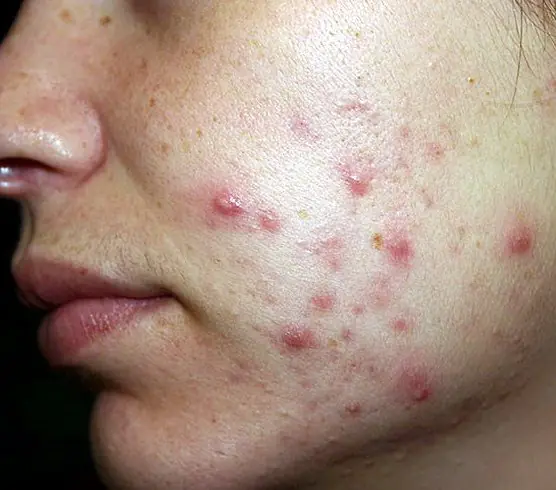
Papulopustular acne is the formation of nodules (papules) and pustules (pustules). These are white internal pimples on the face that can damage the deep layers of the dermis and leave behind marks in the form of dark spots.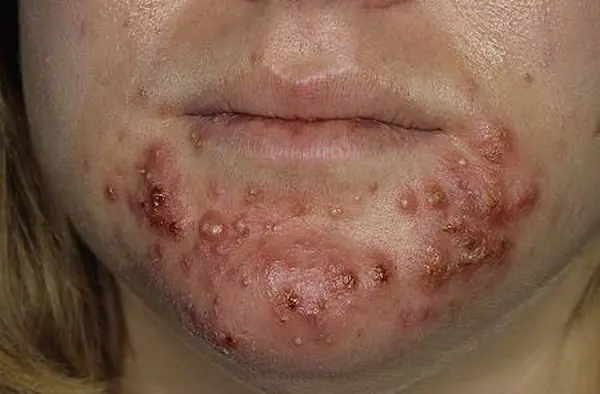
Cystic acne is a severe form of acne, affecting the deep layers of the epidermis, causing hyperemia and pain in the localized areas of the rash. Internal painful pimples are bluish nodules that, as they mature, turn into cysts that fill with pus. After their resolution, deep scars and cicatrices remain on the skin.
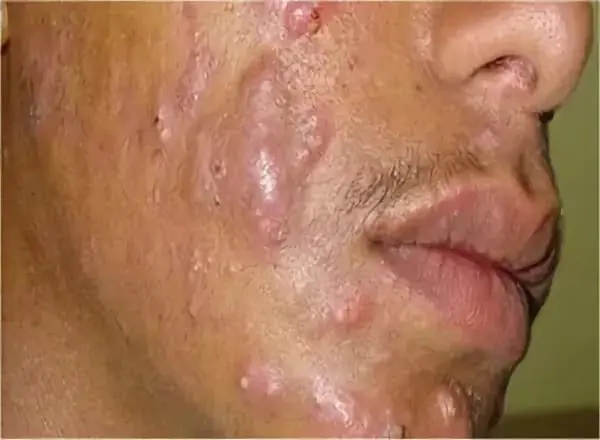
Conglobate or spherical acne has a bumpy surface with a dense structure. Such large internal pimples on the face are very painful and cause tightness of the skin. They are characterized by a purplish-bluish tint. The outcome of such rashes is deep scars.
Causes of internal acne
Internal acne on the face, the causes of which may depend on multiple factors, requires timely diagnosis and treatment. The main reasons for the development of severe forms of acne are:
- hormonal changes;
- unhealthy diet and bad habits;
- weakened immune system;
- internal pathologies;
- use of hormonal drugs.
Hormonal surges in the body are observed in adolescents, as well as during pregnancy, the menstrual cycle and menopause in women. The activity of hormones at this time has a direct impact on the functioning of the sebaceous glands, which begin to actively produce skin secretions. Excess sebum and dead epidermal cells clog the sebaceous ducts, which leads to the active proliferation of bacteria and the occurrence of an inflammatory process.
After leveling out the hormonal levels, as a rule, the work of the sebaceous glands normalizes and the inflammatory process subsides.
Frequent abuse of fast food, fried, fatty foods, alcohol and other harmful products inevitably leads to metabolic disorders and active functioning of the sebaceous glands, which results in the appearance of internal acne on the face.
Infectious diseases that lead to a decrease in immunity cause the inability of the skin to resist the development of pathogenic microflora. The consequence of this is an inflammatory process with damage to the deep layers of the dermis.
Internal pathologies such as diabetes mellitus and diseases of the gastrointestinal tract are often responsible for the development of severe acne. In diabetes mellitus, changes in hormonal levels are observed, which leads to intense secretion of skin secretions. Gastrointestinal pathologies lead to a weakening of the immune system, accumulation of waste and toxins in the body and other disorders, which inevitably affects the condition of the skin over time.
Taking hormonal drugs is another reason why internal acne appears on the face. This category of medications includes inhibitors, oral contraceptives and insulin.
Differential diagnosis
Internal acne on the face, the causes and treatment of which should be determined exclusively by a specialist, first requires differential diagnosis. Based on the results obtained, the doctor decides how to treat internal acne on the face.
If subcutaneous rashes occur, the patient should first consult a dermatologist. Already with a visual examination, a specialist can determine the severity of acne. After the examination, tests are prescribed to identify the cause of acne and determine the form of the skin disease. For this purpose, the following types of examination are prescribed:
- blood chemistry;
- pH-metry;
- dermatoscopy;
- bac sowing
The pH-metry procedure allows you to differentiate one or another form of acne.
Dermatoscopy is intended for visual assessment of inflammatory processes occurring in the dermis.
Bacterial culture is carried out to determine the type of bacteria and their resistance to certain antibiotics.
Additionally, you may need to consult an endocrinologist, gastroenterologist and gynecologist.
Methods of therapy
Today there are many ways to get rid of internal acne. As a rule, severe acne requires an integrated approach to treatment and may include several methods at once, the main of which are:
- taking retinoids;
- antibiotic therapy;
- local anti-acne drugs;
- physiotherapy.
Treatment of internal acne on the face can also additionally be carried out using diet therapy and folk remedies.
Treatment of severe forms of acne with retinoids
When many internal rashes are localized on the skin of the face and body, which do not go away and cannot be treated with local therapy, drugs of the retinoid group are prescribed. These include:
Retinoids are the most effective way to get rid of internal acne on the face and body. They suppress the activity of the sebaceous glands, as a result of which the inflammatory process subsides.

The duration of treatment with drugs in this category depends on the severity of acne. Retinoid helps to completely get rid of internal acne in 4-6 months. In more severe cases, a repeated course of treatment is carried out.
Medicines from the retinoid group should be prescribed exclusively by a specialist after obtaining tests and identifying the cause of internal acne on the face. Taking such drugs without consulting a doctor is dangerous, as they have many contraindications and often lead to serious side effects.
Taking antibiotics for subcutaneous acne
Subcutaneous acne, which is difficult to treat, in some cases requires antibiotic therapy. The most commonly prescribed antibiotics are:
- Doxycycline;
- Unidox Solutab;
- Minolexin;
- Minocycline.
Attention! The choice of antibiotic depends on the results of bacterial culture, during which the resistance of pathogenic microorganisms to a particular drug is revealed.
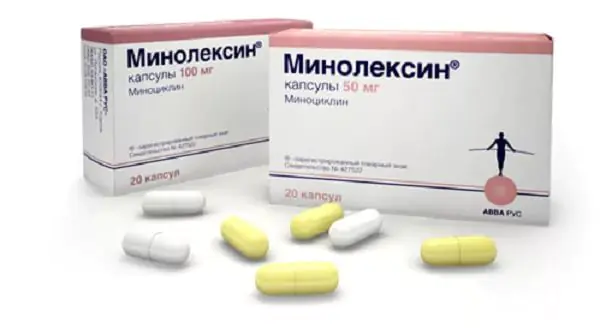
The dosage and course of treatment is determined by the doctor after passing all the tests and identifying the cause of acne. The treatment regimen is also adjusted depending on age and individual characteristics of the disease.
Antibiotics can quickly eliminate redness, itching and pain. The duration of treatment varies from 6 to 8 weeks, after which complete recovery occurs.
After treatment with antibiotics, a course of taking probiotics is indicated to restore beneficial microflora and strengthen the immune system.
Local remedies for internal acne
Using topical medications is one of the methods to get rid of internal acne on the face at home. You can fight subcutaneous rashes using the following means:
- azelaic acid;
- benzoyl peroxide;
- retinol
Azelloic acid is contained in the drugs Skinoklir, Skinoren, Azix-Derm. These products effectively relieve inflammation, normalize the functioning of the sebaceous glands and have an antibacterial effect.
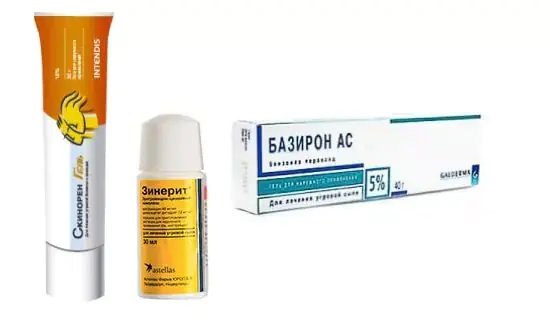
Benzoyl peroxide contains Baziron AS, which is widely used in the treatment of acne. A remedy for internal acne on the face not only effectively eliminates the inflammatory process, but also reduces the risk of scars.
Retinol-based drugs such as Adapalene and Clenzit are produced. They prevent the formation of cysts and reduce the production of skin secretions, thereby preventing scarring after subcutaneous acne resolves.
Ointments for quickly eliminating internal acne
Using pulling ointments is an effective way to quickly get rid of internal acne on the face at home. Local remedies in this category accelerate the process of release of purulent contents. Extractive ointments include Levomekol, Ichthyol ointment, and balsamic liniment. They are intended for spot application.
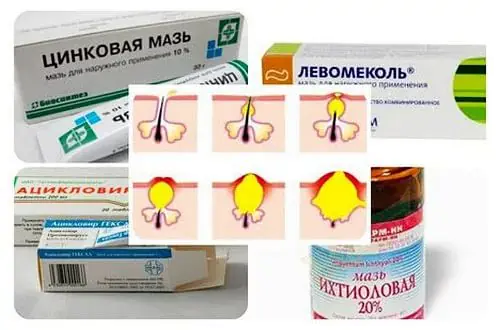
Ichthyol ointment for internal acne on the face is very popular. It helps not only to draw out pus, but also has an anti-inflammatory and antiseptic effect. Also, the local drug is capable of dissolving the contents of the abscess; it is often used to treat colds and acne. After the abscess resolves, further use of the ointment is not recommended. For faster healing of the resulting wound after the infiltrate is released, balsamic Liniment is used.
The use of Levomekol is another effective way to quickly remove an internal pimple on the face. The product has a similar principle of action as Ichthyol ointment.
Physiotherapeutic treatments
Physiotherapy methods, which include the following procedures, help to effectively get rid of deep acne:
- laser beam treatment;
- phytotherapy;
- Darsonvalization.
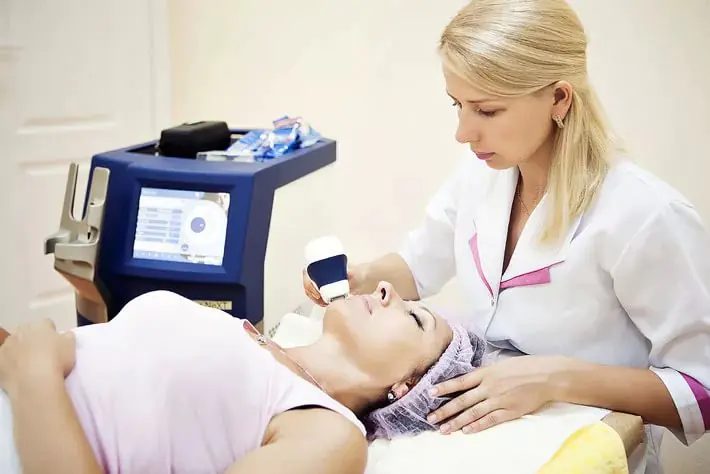
Treatment using the above methods helps to quickly get rid of rashes by improving blood circulation in the dermis, reducing the inflammatory process and strengthening the local protective functions of the body. Physiotherapy techniques also reduce the risk of scarring and cicatricial scarring once acne has resolved.
Additional therapies
Folk remedies are one of the ways to remove an internal pimple on the face. Treatment with alternative medicine methods can only be used as an additional, but not primary therapy. To reduce inflammation and faster maturation of the abscess, the following means are used:
Aloe is one of the most effective folk methods to cure internal pimple on the face. The herbal component relieves inflammation, reduces pain and promotes faster maturation of the abscess. The aloe leaf is first cut lengthwise and the pulp is applied to the sore spot overnight, securing it with a band-aid.
Tea tree oil has antiseptic, anti-inflammatory and analgesic effects. It is applied several times a day to the areas affected by the inflammatory process until complete healing.
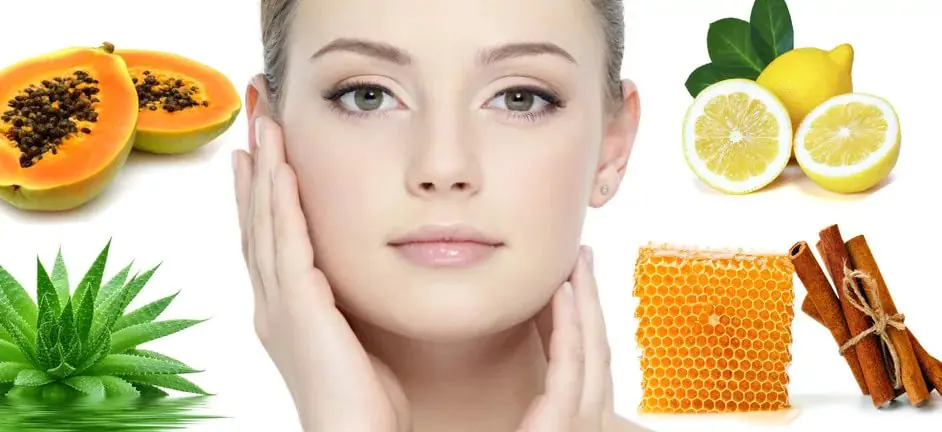
Honey is a powerful natural antibiotic that is used in the treatment of not only internal acne, but also boils. It effectively relieves inflammation and has a bactericidal effect. In folk medicine it is used in combination with rye flour. The bee product, which has a liquid consistency, is mixed with rye flour in a ratio of one to two. The resulting mixture is applied pointwise to the inflamed areas and covered with a gauze bandage, secured with a plaster. The procedure is carried out daily until the inflammatory process in the skin completely subsides.
In folk medicine, there are many ways to get rid of it if you have an internal pimple on your face. However, they are not able to replace the main methods of therapy for severe forms of acne.
As an additional method for faster healing, diet therapy is used. Medical nutrition excludes the consumption of fatty, fried, sweet and smoked products. Also prohibited are processed foods, fast food, carbonated drinks and alcohol. The above category of products provokes the active work of the sebaceous glands and delays the healing process.
When treating internal acne, the diet should include as many fresh vegetables, fruits, nuts, berries, fermented milk products and freshly squeezed juices as possible. High-quality protein also plays an equally important role: the menu should include sea fish, lean meats and eggs.
The duration of diet therapy depends on the severity of acne and is at least one month.
Is it possible to squeeze out internal pimples?
Experts categorically do not recommend squeezing out internal pimples not only on the face, but also on the body. If you squeeze out a subcutaneous acne, there is a high risk of infection, which can lead to sepsis (blood poisoning) and necrosis (tissue death). In addition, if you try to remove an internal pimple mechanically, a deep scar will form in its place. It is for these reasons that dermatologists and cosmetologists do not recommend squeezing at home.
Acne prevention
A healthy lifestyle, proper nutrition, facial skin care, timely detection and treatment of internal pathologies will significantly reduce the risk of developing internal acne relapses.



